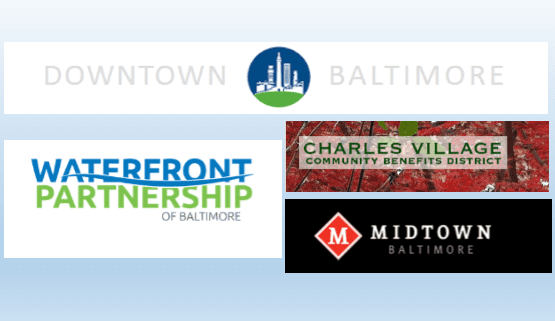Baltimore does not utilize special benefits taxing districts specifically for parks, but has successfully created special benefits districts for businesses.[1] For instance, the Downtown Partnership and Waterfront Partnership manage two special business districts in Baltimore’s downtown core.[2] Management of both districts are funded through a surcharge on assessed commercial properties within specified boundaries.[3] Both business interest districts have existed for years and their successes and the value they add to the businesses within their districts can be tracked through their annual reports.[4] The value added to the local business districts are also measured in economic reports commissioned by the district managers.[5] Further evidence of the success of these business interest districts can be seen in the performance evaluation and re-authorization process that happens every three years.[6]
Although management of these business interest districts revolves around a variety of functions, both the Downtown Partnership and Waterfront Partnership use portions of their funds to maintain and manage several parks within their boundaries. For instance, the Downtown Partnership is heavily involved in park maintenance, programming and operations at several downtown parks.[7] The Downtown Partnership commissioned the development of an open space plan for Downtown that focused in part on enhancing existing parks and other open spaces and creating new open space within district boundaries.[8] Like the Downtown Partnership, the Waterfront Partnership also helps maintain and manage parks within its boundaries.[9] In 2017, the Waterfront Partnership helped the Recreation and Parks Department lead the way in developing a strategic plan for Rash Field – a prominent park within its boundaries – along with other open space plans at the Inner Harbor.[10]
Baltimore has also created another type of special taxing district – a community interest district.[11] Community interest districts are funded through property tax assessments on businesses within their boundaries in conjunction with a tax on residential properties.[12] The services provided within these districts are similar to those provided in business interest districts.[13] Both districts focus on safety, cleanliness and promotion of the district along with developing strategic long-term plan.[14] Like the business interest districts, community interest districts require a performance evaluation prior to an annual re-authorization to ensure these districts succeed in their operations.[15]
Two community interest districts are authorized to operate in Baltimore – the Midtown Community Benefits District and the Charles Village Community Benefits District.[16] The Charles Village Community Benefits District does not maintain parks but inspects and reports problems with parks within their boundaries.[17] Management for the Midtown District, however, helps maintain sixteen parks.[18] Services provided to parks in the Midtown District are limited to cleaning, weeding, edging and watering with major maintenance left to the Recreation and Parks Department.[19]
The successful operation of the business interest districts and community benefits districts can be duplicated at Patterson Park through the creation of a special park benefits district. Baltimore’s tax collection system and the legislative framework to establish a park benefit district already exists. The residents of the surrounding communities are committed to Patterson Park and actively seek improvements. The Friends of Patterson Park already has employees that work at the park on a full-time basis, are experienced in park and financial management and work in partnership with the Recreation and Parks Department. The Friends of Patterson Park and the Recreation and Parks Department already have the management and operational structure for successful cooperation. All the elements are in place to use the special benefits district model that currently exists to help fund Patterson Park’s lagging maintenance and operations budgets. Patterson Park is well positioned to take advantage of such a model.
[1] Baltimore City Code, Special Benefits Districts, Art. 14. (2018)
[2] Downtown Partnership, http://godowntownbaltimore.com/about/index.aspx; Waterfront Partnership, http://baltimorewaterfront.com/mission/.
[3] In 2017, the Downtown business interest district charges 22.39 cents per $100 of assessed commercial property value. County & Municipal Property Tax Rates in Effect for July 1, 2017 Tax Bills, http://dat.maryland.gov/Documents/statistics/Taxrate_July12016.pdf. The Waterfront district pays 12.5 cents per $100 of assessed commercial property value.
[4] Downtown Partnership, Annual Report; Waterfront Partnership, Annual Report.
[5] Downtown Partnership, Economic Impact of Downtown Baltimore (2016), http://www.godowntownbaltimore.com/library/docs/Econ_Impact_16.pdf; Waterfront Partnership, Baltimore’s Inner Harbor: Economic Impact, Importance and Opportunities for Investment (Oct. 31, 2013), http://baltimorewaterfront.com/wp-content/uploads/2015/06/Economic-Impact-Study.pdf.
[6] Baltimore City Code, Special Benefits Districts, art. 14, §§1-20, 8-16.
[7] Downtown Partnership, Annual Report at 4.
[8] Downtown Partnership, Downtown Open Space Plan (2015), http://www.godowntownbaltimore.com/docs/openspaceplan.pdf.
[9] Waterfront Partnership, Annual Report at 18.
[10] Waterfront Partnership, Annual Report at 18.
[11] Baltimore City Code, Special Benefits Districts, Art. 14, subtitles 6 and 7.
[12] County & Municipal Property Tax Rates in Effect for July 1, 2017 Tax Bills.
[13] Midtown Baltimore, District Parks & Services, http://midtownbaltimore.org/wp-content/uploads/2011/08/MIDTOWN-DISTRICT-PARKS-9-18-17.pdf; Charles Village Community Benefits District, Program Services Mix FY 2018, http://charlesvillage.org/wp-content/uploads/2013/06/Program-Services-Mix-FY-2018-July-2017.pdf.
[14] Downtown Partnership, Annual Report (2017); Waterfront Partnership, Annual Report (2017).
[15] Baltimore City Code, Special Benefits Districts, Art. 14, subtitles 6-16, 7-16.
[16] Baltimore City Code, Special Benefits Districts, Art. 14, subtitle 6 and 7.
[17] Charles Village Community Benefits District.
[18] Midtown Baltimore, District Parks & Services
[19] Midtown Baltimore, District Parks & Services

Be the first to comment on "No. 12 – Special benefits districts are not just for businesses"